Feature
Preschool in a Science Center
Connected Science Learning October-December 2017 (Volume 1, Issue 4)
By Amber Forrest, Jolie Pelds, and Renee Harmon
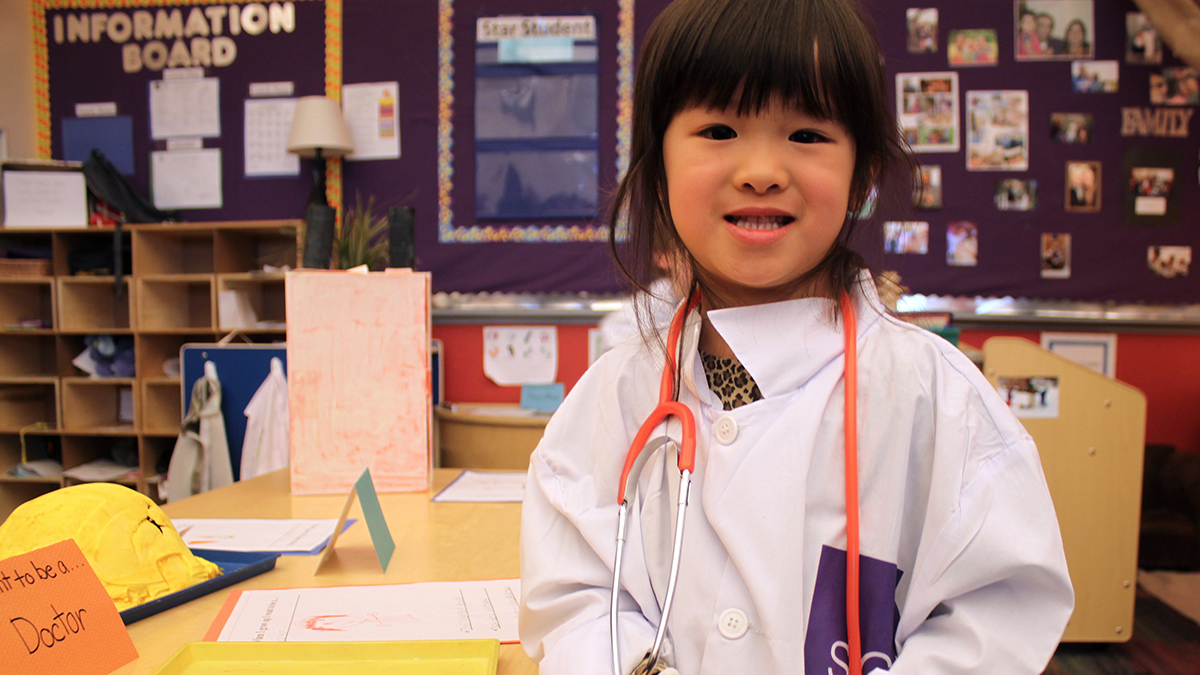
The Science Center of Iowa in Des Moines began an on-site preschool shortly after its doors opened in 1970, inspired by the founders’ belief in the importance of science education for early childhood learners.
Children have the capacity and propensity to observe and explore the world around them from an early age. To foster these innate abilities, students must be provided with STEM (science, technology, engineering, and math) experiences early in life to begin forging learning pathways in their brains. These learning pathways help the brain channel new information through prior experiences (Harris Helm 2015).
The Science Center of Iowa (SCI) fuses early STEM education for young children with an on-site preschool. The mission of the SCI is to engage and inspire Iowans along their journey of lifelong science learning. SCI believes that science education for early childhood learners is important to the start of that journey, and thus established an active on-site preschool shortly after the museum opened in 1970. Since then, more than 3,000 curious, energetic young STEM learners have experimented, created, and explored both at the SCI Preschool and within the walls of the museum itself. Daily opportunities to interact with exhibits and museum staff makes this preschool unique, and graduates feel a deep connection to the organization and its philosophy of education. In June 2016, SCI Preschool alum Alissa Campbell wrote:
This May, I graduated from Iowa State University with a B.S. in Microbiology and a B.S. in Genetics, both with honors. I am blessed with the opportunity to attend Harvard Medical School this fall. I want you to know that everything you did for this little blue-eyed girl with platinum blonde curls and an obsession with knowing how everything around her worked mattered. Your work contributed to my foundational love of science, and that love will last a lifetime.
SCI and Our Philosophy
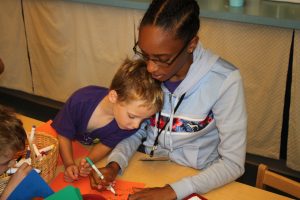
SCI Preschool is a state-licensed child care center adhering to National Association for the Education of Young Children (NAEYC) regulations. Four on-site classrooms provide space for three full-day and three part-day classes serving 112 students annually.
Well-educated and caring, certified teachers set the tone for the classroom experience.
SCI Preschool staff fall into one of four classifications: director, master teacher, teacher, and part-time teacher. The SCI preschool director is required to have a master’s degree in education. The director assumes full responsibility for administration of preschool operations, including staff management, parental support, and management of daily operations, as well as serving as a link between the preschool and the science center. The director models and guides teachers in pedagogy and procedures, designs the annual budget and business plan, and coordinates family events, among other programmatic and administrative duties. The assistant director manages schedules, tracks expenses, orders supplies, and teaches a part-time class. Master teachers, who are required to have a bachelor’s degree in education and typically a concentration in early childhood, serve as the lead in their classrooms. Their role includes establishing the classroom environment, creating lesson plans, assessing students and collecting documentation through observation, communicating with parents, and, of course, educating young minds. Teachers and part-time teachers assist the master teacher in the classroom.
Healthy partnerships between parents and the school provide the best early experience possible for a young child. Research indicates that children have a better attitude and tend to succeed more in school when their families are involved in their education. Parents or guardians are also more aware of their child’s social and intellectual state and more confident in their parenting skills and decision-making abilities. Parent involvement also benefits the school, as parents are more likely to heed teachers’ plans and recommendations (Olsen and Fuller 2008).
Creative Curriculum and the Project Approach
The SCI Preschool uses the Creative Curriculum, a developmentally appropriate early childhood curriculum with a framework designed for young children’s optimal learning and development. The curriculum emphasizes the intersection of appropriate environment and schedule with positive teacher and child interactions to support the growth of the whole child in development and content knowledge, including social/emotional, cognitive, physical, language, literacy, math, social studies, science, and the arts. This curriculum, along with the Project Approach method, is implemented in each classroom.
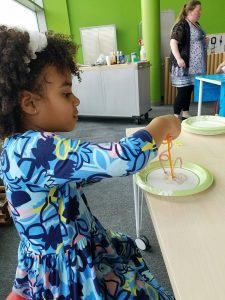
The Project Approach is a method of teaching in which the class conducts an in-depth investigation on a particular topic. Children study one topic for an extended period of time, lasting four to eight weeks on average. The selected topic should be broad enough for multiple avenues of expansion, interest, and relevance to the children’s lives. Topics that have been investigated include pizza, juice, ice cream, bees, trains, movies, and shoes. These topics were successful because they were close to the children’s self, meaning that they were related to something that they see or do in their everyday lives. This investigation and engagement guides early learners to explore surprisingly deep concepts. Teachers also integrate content knowledge such as math, reading, and science into their project studies. In project work, the children ask questions and formulate their own plans to find the answers, with the assistance of the teachers. For their projects, students plan interview questions, look at books, draw and write what they observe, and create plans for building structures and play environments. Field site visits and expert guest speakers are often also included in project learning. As the children learn, they will redraw, rewrite and record their findings in the form of posters, murals, artwork, graphs and charts, constructions, models, and journals (Harris Helm and Katz 2016).
Enhancing Education With Museum Resources
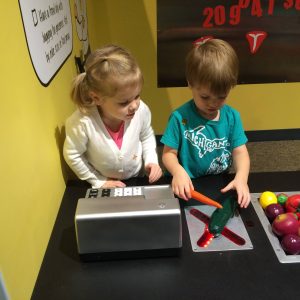
Preschoolers have daily immersion in a STEM-oriented environment through museum exhibits, programs, and shared expertise. Within the Project Approach, the museum’s exhibits act as a continuous field site visit. These visits allow children to play, draw, ask questions, and reflect about what they have learned. SCI’s Small Discoveries exhibit was designed with this type of learner in mind. After viewing this exhibit, preschoolers became interested in the exhibit’s new milking cow. This class of four- and five-year-olds spent several weeks studying dairy cows and milk products, which eventually led them to think about ice cream. Several children posed the question, “What are all the kinds of ice cream?” From there, they asked how Dippin’ Dots were made. Their teacher engaged SCI program staff to help them answer this question.
Expert visitors are another important element of the Project Approach model. Experts interested in and comfortable with working with preschool children can be challenging to find. SCI has a pool of on-site experts on subjects such as chemistry, animals, construction, nature, and other STEM topics. As the preschoolers develop relationships with the SCI program presenters, they become more likely to ask deeper questions and see the staff as science mentors. One program offered to the public is called Fire and Ice. This program includes several experiments that use liquid nitrogen to demonstrate thermodynamics. Program presenters are trained to handle these materials safely and were able to adapt this program to demonstrate how Dippin’ Dots are made.
Shared Staff Development and Expertise
The relationship between SCI and its preschool is one that nurtures collaboration and professional learning that benefits students, staff, and visitors alike. This blended community creates a rich environment of idea sharing, innovation, and support that can be seen in many aspects of the museum.
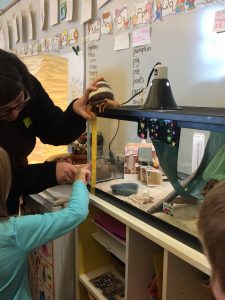
Liesl Downs has worked at SCI since summer 2014. She was initially hired as a camp counselor and was able to join the Preschool team at the beginning of the 2014–15 school year. After earning a bachelor’s degree from Iowa State University in elementary education with a concentration in early childhood and special education, Liesl gained additional critical skills during her time working at the camp that have supported her transition to the preschool. These skills include working with a coteacher, communicating with families, locating resources in the science center, using exhibits to enhance lessons, and building relationships with other staff members.
Originally hired in 2015 as a summer resident maker at SCI, Ellie Willhoit has also worked for SCI as a program coordinator and preschool educator. During her first few weeks at the preschool, Ellie quickly learned strategies for managing groups of students in the classroom. Some techniques were learned through trial and error, whereas some came from interactions with the early childhood director and other preschool teachers. In turn, Ellie also has been a STEM resource for the teachers in the preschool. In Liesl’s classroom, students were working on a project centered around hermit crabs. The goal of this project, like many others, was to cultivate early skills, such as learning to ask questions, recording data, using tools and technology, doing observational drawing (taking notes), designing experiments, and gaining basic content knowledge about living things within a topic that relates to the children’s world. Program staff who work with the museum’s animals came and spoke to the class about the difference between a hermit crab, which is a crustacean, and a snail, which is a gastropod. Students became especially interested in the shell that hermit crabs carry on their backs. Ellie spoke with the class to ask what characteristics they had observed a shell would need to be suitable for a hermit crab to inhabit. She took students’ ideas, designed their shell on her computer, and then brought a 3-D printer into the classroom so students could watch it print. After printing was complete, Ellie showed them how to cut away the support structures to reveal the shell. Students were able to hold the shell and measure it against one of the crabs. They decided the shell was too big and worked with Ellie on a redesigned structure. Liesl, who had never used a 3-D printer before, gained an understanding of how one could be useful in the classroom. Students learned that a 3-D printer can be used to create something that was designed on a computer. A few preschool parents even reported that their students consequently asked for a 3-D printer of their own.
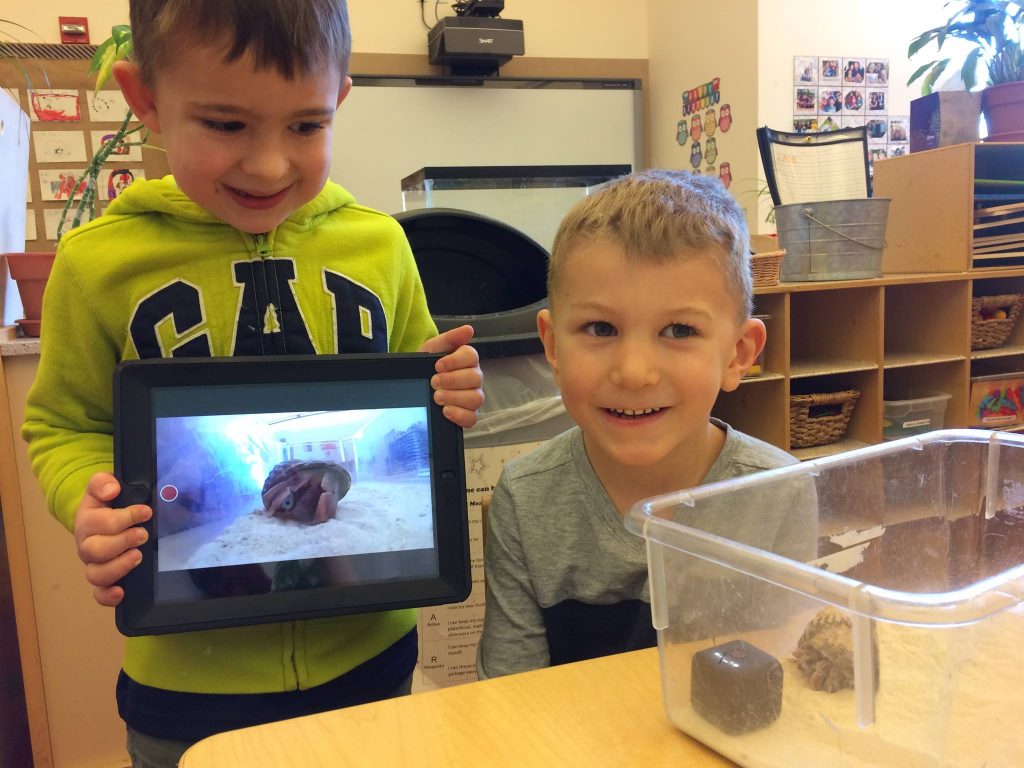
The activity later led the class to wonder what hermit crabs did at night after students left. Liesl spoke with SCI staff to find a solution. Having used GoPro cameras for other projects, the education specialist brought a camera into the class. It was set up in the crab’s habitat to livestream the crab’s actions and observe its interactions with its environment. The GoPro allowed the preschoolers to answer their question in an authentic way, like a real scientist would observe and record data.
Challenges Faced
Because the preschool is in the science center, students are out in public spaces more often than children in more traditional preschool settings. Safety is a core value of both SCI and the SCI Preschool. Classrooms are located in a secure wing of the facility with access restricted to preschool staff members. An enhanced security system is in place that can lock down the preschool and notify others in the case of an emergency. When children go into the Science Center, they wear lab coats so that they can be easily identified as students.
Communication can be a challenge due to the nature of a running an early childhood care center. As a result, an increased sense of urgency is placed on communication about shared spaces, staff, and materials. The preschool director attends all SCI leadership meetings and is part of the Science Learning Division of the organization, which, in addition to the preschool, includes internal and external programming, exhibits, and formal education partnerships. The preschool director acts as a constant liaison for increased communication, understanding of differing process, and diligence in safety.
Evaluation
Formal evaluation looks different in settings that are focused on young learners. SCI believes that authentic assessment, as real-time observation, is critical to providing support for continuous improvement. This is replicated in overall program evaluation, which uses a multilayered approach to evaluate the program, teachers, and learners.
The NAEYC requires robust evaluation for their accredited programs; including conducting a self-study and assessment and meeting the highest program standards for quality and early learning. The accreditation process consists of an on-site review, program portfolio assessment, and parent feedback evaluation. In addition to the NAEYC evaluation, a quarterly family survey is conducted to assess curriculum impact, teacher and director quality interaction, and facility/environment. The SCI Preschool believes that parents are their child’s first and most important teachers, and as such, they are valued as true partners in the preschool program. Feedback is analyzed and examined by SCI’s executive team and the preschool’s Parent Advisory Committee. In the 2017 survey, results showed that 98% of responding families believed that communication was ongoing and clear and that staff had knowledge and expertise that was current with best practices for high-quality care. Families indicated they would like their children to have more opportunities for learning in physical fitness, languages, and art. We included these elements in our plan for the future, along with an action plan to incorporate adult volunteers with expertise in these three areas to lead lessons each month.
Learners are evaluated using Teaching Strategies Gold, an online observation-based assessment approach aligned with the Creative Curriculum, to analyze each child’s progress in the development of social, physical, language, cognitive, science, math, literacy, and arts abilities. The results are shared twice a year in parent–teacher conferences, which include discussion about assessments and goal setting. The SCI Preschool uses these assessments to guide daily instruction and provide extra support for children’s individual needs. According to 2016–2017 school year assessments, the percentage of SCI preschoolers who reached kindergarten readiness targets in all learning domains increased from 80% in the fall to 95% by spring.
Comparison With Other Science Center Preschools
Although the Science Center of Iowa is one of the longest-running preschools based at a science center, it is not the only one. Over the years, SCI’s preschool has received numerous inquiries from museums, cultural institutions, and science centers across the United States, all of whom were seeking to emulate our model. Other institutions have asked for information about SCI Preschool’s structure, security, procedures, and routines, and they have also requested to observe our spaces and speak to our administrators. At the Orlando Science Center (OSC), an on-site preschool was opened in 2009. OSC operates four preschool classes with a maximum capacity of 72 students, frequently operating with a waitlist. The OSC Preschool is an approved voluntary prekindergarten provider in the state of Florida, which allows children who are four years old by September 1 to be eligible for state funding for preschool. According to Heather Norton, vice president of education at OSC, “Our STEM preschool allows us to foster a love of science at a very early age and capitalize on the natural curiosity of young children.” In 2015, the Indianapolis Museum of Art’s (IMA) preschool opened with a commitment to serve diverse families in a museum setting. Annually, the IMA program welcomes children ages 3–5 for part-time and full-day experiences. The organization is focused on maintaining a needs-based scholarship component to reach children in poverty.
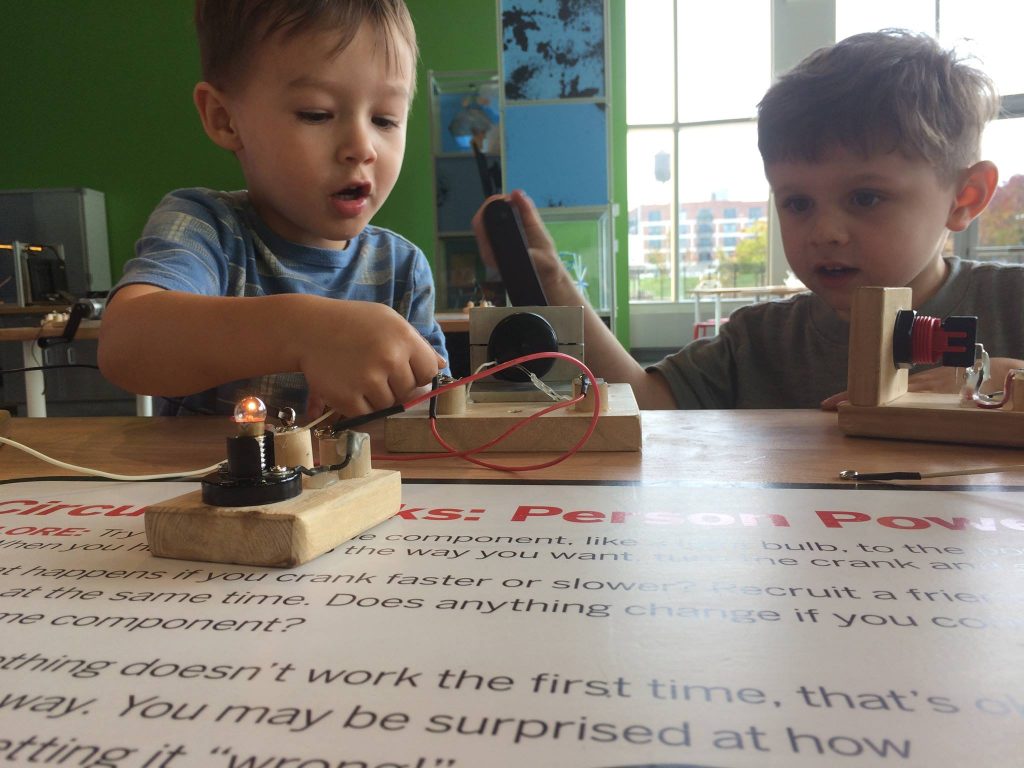
Preschools within science centers and other cultural institutions are still uncommon, but their popularity is increasing. Heidi Davis-Soylu of IMA believes that the arrangement is mutually beneficial to both the preschool and the institution: “Preschoolers bring a terrific energy to the building and have helped unite departments internally, such as the relationships they have built with security guards.”
Preschool and SCI Sustainability
SCI believes that the primary role of a preschool is to support the first steps in a child’s journey of learning. All preschool families are required to purchase memberships to the Science Center of Iowa, which supports the museum as a whole. The museum becomes a place for the entire family to enjoy. Children have access to their school and have opportunities to share their learning spaces and work with their families any day of the week. Museum research shows that “the primary catalyst for causing an individual to visit a museum in the present are events that happened in the past,” which is to say that positive first experiences at a museum generally entice visitors to return (Falk 2009). In this sense, the preschool can be seen as an investment by SCI in the center as a whole.
The SCI Preschool also partners with Des Moines Public Schools through the Statewide Voluntary Preschool Program (SVPP). These partnerships keep SCI Preschool enrollment consistent and accessible. This program, specifically for four-year-olds, promotes the availability of early childhood education for all students. The partnership provides families with funding for 10 hours of preschool per week during the school year. In addition, SVPP provides access to support for needs such as speech therapy, behavioral support, and developmental delays. This partnership aides in financial and resource sustainability of the SCI Preschool and allows access to families who may otherwise not be financially able to attend.
Fueling a Lifelong Commitment to Science
Sustained engagement is a concept that museums of all kinds are working to establish and maintain. To achieve sustained engagement, museums must seek new ways to stay relevant, attract and retain visitors, and secure their position as important cultural institutions (Everett and Barrett 2009). Through its on-site preschool, SCI strives to establish a personal connection with students that is unique and ongoing throughout different stages of life. Nearly 25% of preschool families maintain their membership for more than five years after their child’s graduation. Of those, approximately 20% continue to purchase memberships to SCI for 10 years or more. This shows a lasting connection between Preschool families and the museum.
Rhiley Binns, a current SCI programs coordinator, attended the SCI Preschool as a young child. Rhiley continues to feel a personal connection to the museum where she spent so much time during her youth. She thinks of SCI as “her school.” Rhiley studied science throughout her life and earned a bachelor of science in biology. During her summers, she led summer camps as a seasonal camp counselor at SCI. Upon graduation, she gained nonprofit experience and eventually became a full-time SCI employee. Rhiley now works as a programs coordinator specializing in astronomy and occasionally works in the preschool, helping young minds grow and develop in a STEM-rich learning environment. Perhaps right now at the preschool, Rhiley is working with a future scientist, business leader, SCI staff member, or a curious learner who will continue to be amazed and ask questions that can be answered at a local science museum.
Amber Forrest (amber.forrest@sciowa.org) is director of early childhood at the Science Center of Iowa in Des Moines, Iowa. Jolie Pelds (jolie.pelds@sciowa.org) is director of innovative STEM teaching at the Science Center of Iowa in Des Moines, Iowa. Renee Harmon (renee.harmon@sciowa.org) is vice president of science learning at the Science Center of Iowa in Des Moines, Iowa.

